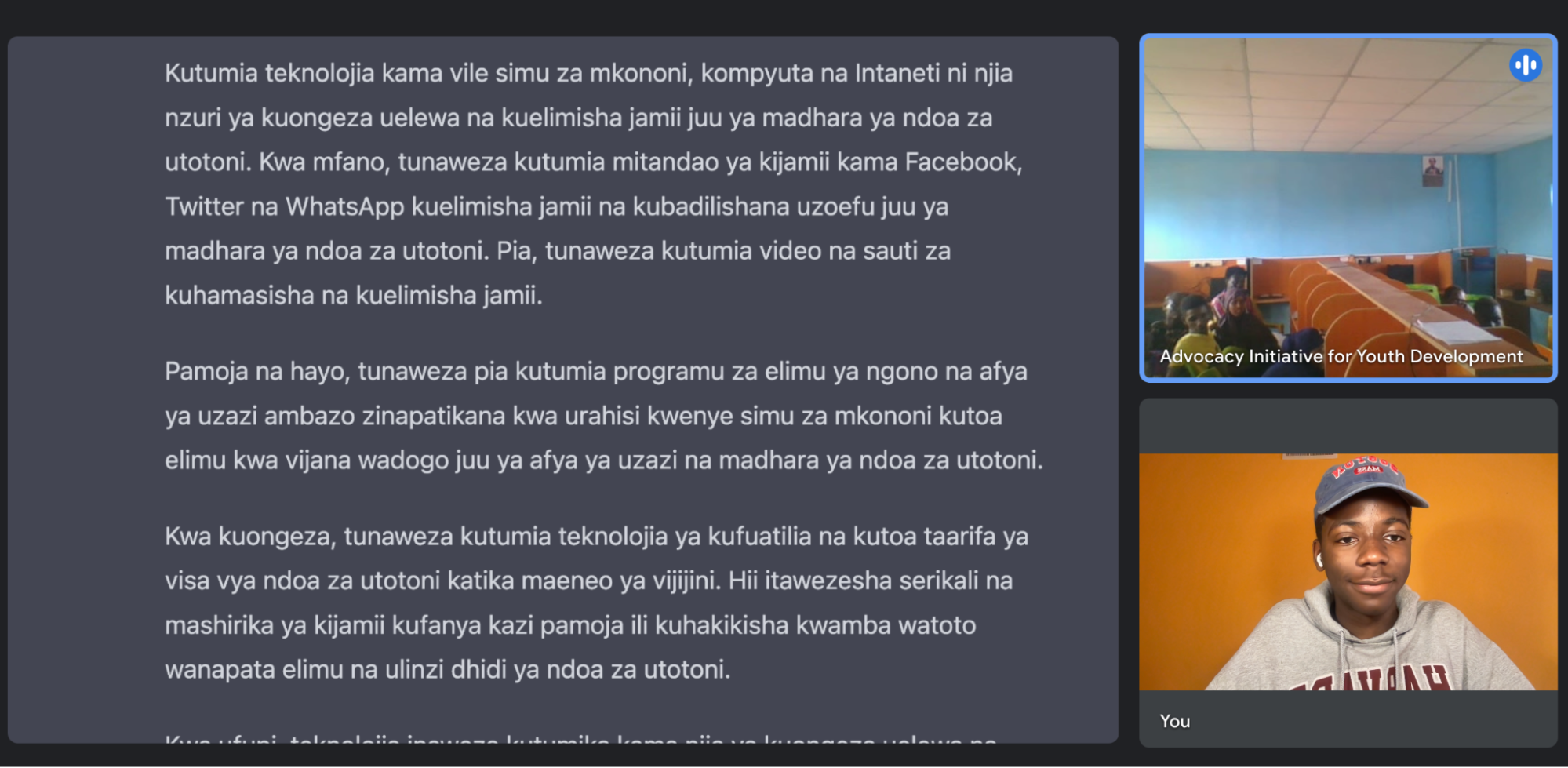As millions of people add artificial intelligence to their workflows, thousands of schools have banned the world’s most popular AI tools like ChatGPT. Activist Okezue Bell argues that we need to reimagine how education and EdTech work to make the most of artificial intelligence.
In the final days of 1989, Tim Berners-Lee was quietly crafting the fabric of what we now know as the internet. Within a decade, his creation had found its way into almost every school across the developed world, all plugged into this seemingly limitless source of collective knowledge. On one hand, the internet offered the academic world an unprecedented canvas for cheating, offering students essays and solutions from across the globe. On the other, it forever altered the classroom, replacing blackboards with digital screens and supplanting encyclopaedias with search engines.
Today, artificial intelligence represents a similar revolution. A tool capable of synthesising, responding to, and generating answers at the click of a button: large language models, or LLMs. Among these, ChatGPT, created by OpenAI, stands out. Trained on a staggering 300 billion words, ChatGPT processes words as mathematical vectors, known as ‘embeddings’, to understand how they relate to each other. For instance, 'rain' and 'umbrella' would be correlated, since they are often used alongside one another. This ability to connect words, almost inferring what they really mean, fuels its use in everything from writing code and translating prose to brainstorming ideas and providing therapeutic support.

But the meeting of artificial intelligence and the education system has not been smooth. Students delegate their essays to ChatGPT en masse, whilst teachers misuse the tool to accuse students of plagiarism. Almost a third of American students report that AI tools are banned at their school, the surest sign of how much AI challenges today’s model of education.
As a Stanford student, researcher, and UN STEM activist, I've gained firsthand experience of the incredible promise and pitfalls of large language models. My work has taken me from policy discussions in White House offices to front-line activism with Encode Justice, combatting biased miscarriages of justice at the hands of AI. At the MIT Media Lab, I've used generative models to create digital avatars for therapeutic and corporate applications. These diverse experiences have fuelled my cautious optimism that a socially-responsive roll-out of powerful AI models is possible, though not inevitable.
Almost a third of American students report that AI tools are banned at their school.
Through the Global STEM Education Initiative, the innovation workshops and educational resources I have been organising for several years, I taught thousands of students from underserved communities across the US, Africa, and Asia how to make the most of ChatGPT. Later, I built a platform that used the same model to build an app, Vivid, which helps teachers (and students) find educational resources on any topic, even those they weren’t experts in themselves. See a demo of the beta version that students are using here.
The results were astounding: students used the AI-powered platform as personal tutors in and outside the classroom, enabling them to access information that they were never aware of and be taught in an engaging way at their own pace. Teachers were using ChatGPT alongside their teaching expertise to curate resources on topics for which they lacked formal textbooks or training. Not only was AI supercharging the students’ capacity, but it also made education on essential, under-taught topics, like financial literacy and menstrual health, possible.

When assessed via Khan Academy and US-national exams over a four-month period, over 70% of the students using LLMs experienced a clear increase in academic quality and performance, with some jumping 2-3 grade levels in maths, chemistry, and reading comprehension. Students began working in tandem with the system, using it for tasks like editing, explanation, or as a creative springboard. Much like the internet did upon its launch into schools, AI was boosting educational faculty and productivity.
On traditional educational platforms, the onus is on the user to discern what they don't yet understand. For instance, if a student using Khan Academy wants to build a slingshot, they must first be aware that the concepts of momentum and force are critical, and that they should engage with the relevant physics modules. Using an LLM like ChatGPT drastically changes this dynamic. The student simply queries, “how do I build a slingshot?” In response, the AI, acting as a tireless, personalised tutor, generates an explanation tailored to the student’s needs.
For this specific example, you could find the results you need on countless kids or crafts websites. But for more general, and especially deeper, learning, the experience of sifting through SEO-optimised content is not only antithetical to learning, but is an experience that the personalised guidance of an LLM completely sidesteps.
The difference lies in how large language models generate new, personalised content from the vast data available online (which they are trained on), whereas search engines curate that online content, prioritising some of it based on the user’s query. The former process invariably offers a more fine-tuned response, effectively 'reading' the internet on behalf of the user and being able to share the information which is most relevant in an accessible, tailored way.

AI is going to change how we learn, and its main impact isn’t enabling cheating, but creating a new, transformative tool through which students can engage with and learn information. Instead of blocking the OpenAI website, which some institutions have done (including my own school!), we need to start having more productive, multi-stakeholder conversations that pump out new ideas, policies, and possibilities.
EdTech companies like Khan Academy and Quizlet have recognised the inevitable direction of travel: Khan Academy has already begun releasing its AI tutor, powered by OpenAI, to some students, whilst Quizlet, which has been developing AI products since 2018, launched its own AI tutor, Q-Chat, to all US adults this spring. “When used effectively,” said Quizlet CEO Lex Bayer at the time, “AI can help students deepen their knowledge and learn more efficiently.”
Students using LLMs experienced a clear increase in academic quality and performance.
However, computer super-tutors barely scratch the surface of what is possible for AI in education. Artificial intelligence can power a blank canvas for students to learn more deeply about their own interests, and more quickly than ever before. It can help teachers use their skills to create lessons on topics that they aren’t familiar with themselves, democratising access to knowledge across the world. Critically, AI can level the playing field for underserved students, whilst empowering those who want to take their learning further.
Its implications are systemic, and will only continue to grow as the dialogue and development surrounding it continue. Young people, as students and the generation inheriting the problems and opportunities we face as humans, must be increasingly involved in and aware of such progress, and I hope that my work will help spearhead that movement.

The challenges that defined the birth of the internet — concerns of misuse; cautious optimism — find their reflections in our modern dance with LLMs. But just as the world did not remain confined to the binary of boon and bane back then, our narrative today isn’t just about balancing potential and peril. Instead, what matters is envisioning the transformative power of technology to reshape education from the ground up.
Today, the hum isn’t just the dial-up tones of the past; it’s the tap of keys and the whispers of AI progress, heralding an age of personalised, accessible learning. And as we form this future, we must do so with a vision that is inclusive, empowering, and constantly evolving, ensuring that the echoes of this transformation resonate in every classroom, for every learner, across the globe.
Vivid will be publicly available for teachers by 2024. It is currently being rolled out on a school-by-school basis to conduct trials.
A socially-responsive roll-out of powerful AI models is possible, though not inevitable.
Okezue Bell is a Nigerian-American inventor. Following research in neuroscience and generatics at Harvard Medical School, he created the WeArm, a prosthetic arm for below-the-elbow amputees costing under $400. Okezue also founded Fidutam, a SIM-based microfinancing application for unbanked, low-infrastructure communities, which has provided over $400,000 in financial runway to thousands of families using blockchain technology. He is a UN STEM activist and has been a researcher at the MIT Media Lab and Boston Children's Hospital.